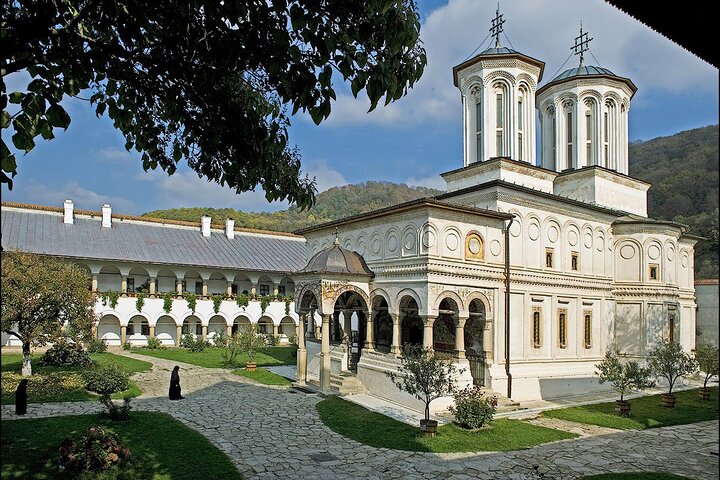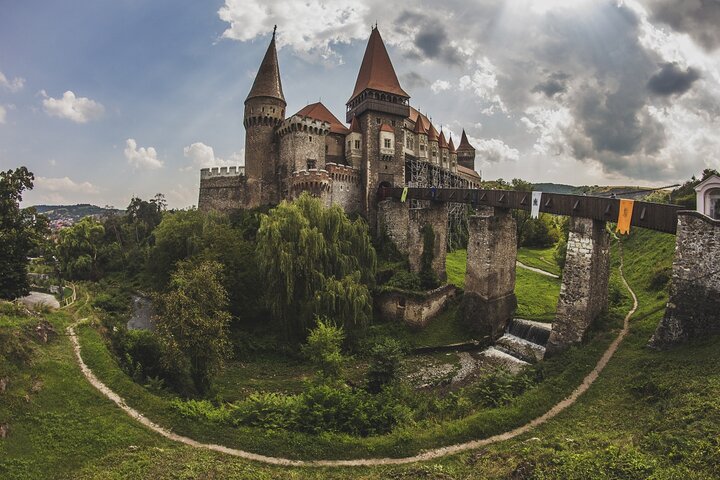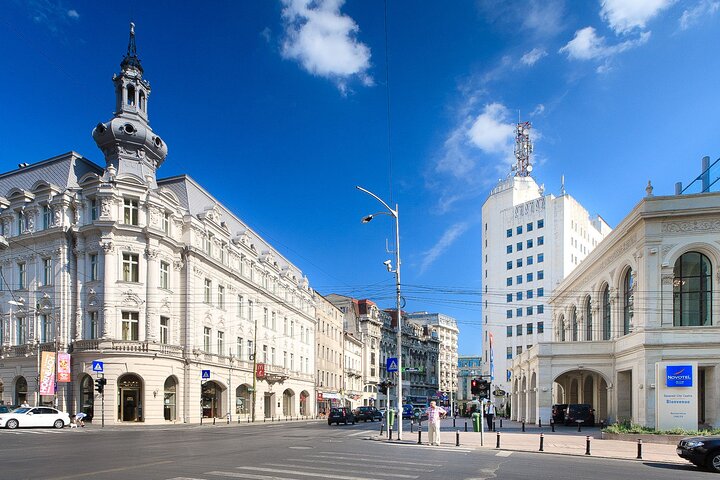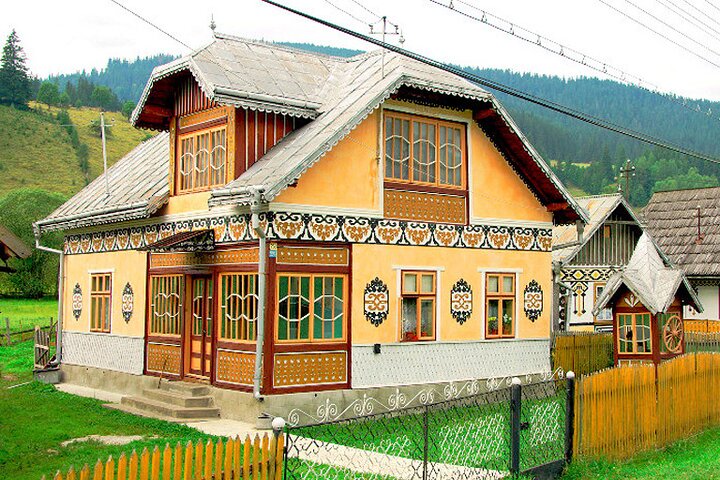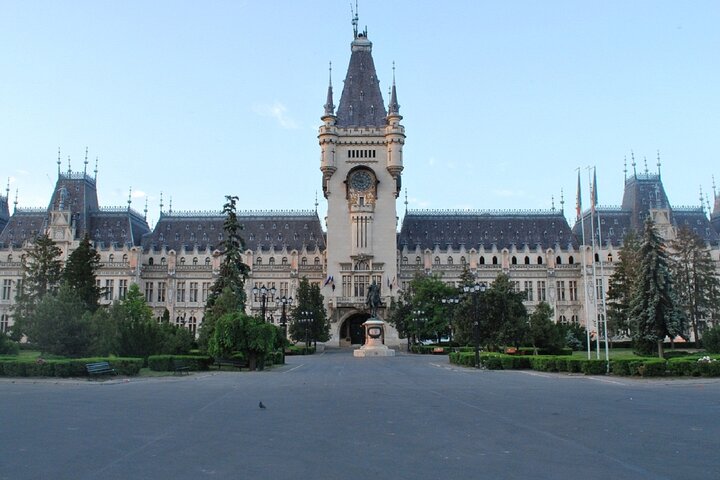Embark on a 9-day private guided tour of Romania from Bucharest. Experience medieval sites, wilderness, modern exhibits, and delicious traditional foods. Join us for an adventure of a lifetime!
Embark on a 9-day private guided tour of Romania from Bucharest. Experience medieval sites, wilderness, modern exhibits, and delicious traditional foods. Join us for an adventure of a lifetime!
Bucharest City Tour - Overnight in Bucharest
Palace of Parliament - On a day trip in Bucharest, you can explore one of the most debated administrative buildings globally. With this private tour of The Palace of Parliament, also known as the People’s House, you will understand the dangers and damages a totalitarian regime like communism can…
Bucharest City Tour - Overnight in Bucharest
Palace of Parliament - On a day trip in Bucharest, you can explore one of the most debated administrative buildings globally. With this private tour of The Palace of Parliament, also known as the People’s House, you will understand the dangers and damages a totalitarian regime like communism can inflict on a nation. Standing before one of the world’s largest constructions, you will feel small, witnessing the pointless opulence and megalomania that “the sleep of reason” can create.
Taking a selfie up-close will be challenging, as you will be trying to capture the second-largest administrative building on the planet, after the Pentagon. This experience will be one to share with your grandchildren.
Muzeul National al Satului “Dimitrie Gusti” - On this private tour, you can visit The Bucharest National Village Museum, where you will see a representation of Romanian traditions and learn about the ecological and sustainable environments Romanian villagers built in their backyards. You will also get a glimpse of their simple and modest lifestyle, in social and spiritual harmony with their surroundings.
Ateneul Roman - Next, your private tour will take you to the Romanian Athenaeum. Here, you will stand before the most representative symbol of Romanian culture, often considered a symbol of Bucharest as well.
It is only natural that it should be one of the most important tourist attractions on Calea Victoriei and in Bucharest.
Piaka Revolukiei - If you are planning a city break in Bucharest, you must visit The Revolution Square, a place with great historical significance. Here, you can be transported back to the moment when the dictator Ceausescu was ousted, leaving behind secrets of a great fortune and controversies about the state security service and his offshore accounts.
As mentioned earlier, when you reach the Senate Palace, you will see the building that used to house the Central Committee of the Romanian Communist Party and the place where the Revolution of December 1989 started, a major historical event where, through human force and sacrifice, Ceausescu was removed from power for good.
Old Town - On a Bucharest day trip, you have the chance to relive the olden days through a blend of mystery and contrasts on the streets of the Historical City Centre, starting with Hanul lui Manuc, an immense fortified inn that served as a cultural and economic center back in the day. Built around 1806 by Manuc Bei, one of the wealthiest landowners in the Balkans, it was where merchants passing through Bucharest would gather, forming part of the colorful crowd that populated the historical inn.
In this historical and cosmopolitan area, with the help of your private guide from Nicolas Experience Tours, you will also find, in addition to the most popular restaurants in Bucharest, museums, old and spectacular churches, and an experiential library where you can purchase books, music, and other souvenirs that will make for an unforgettable experience for you and your loved ones.
Palatul Patriarhiei - The Romanian Orthodox Patriarchal Cathedral (also known as the Metropolitan Church) is a functioning religious and civic landmark on Dealul Mitropoliei in Bucharest, Romania. It is located near the Palace of the Chamber of Deputies of the Patriarchate of the Romanian Orthodox Church. As a working cathedral, it is the site of many religious holidays and observances for those who follow the Orthodox Christian faith in Bucharest, including a Palm Sunday pilgrimage. The Orthodox Divine Liturgy at the cathedral is known for its a cappella choir, a common practice shared by all the Orthodox churches in both their prayer services and liturgical rites. The Romanian Orthodox Patriarchal Cathedral is a designated Historical monument—Monument istoric of Romania.
1. Curtea de Arges Monastery 2. Poenari Castle 3. Transfagarasan Highway 4. Sibiu City Tour - Overnight stay in Sibiu
Curtea de Arges Monastery - Did you know that Curtea de Arges is unique for the important royal tombs it hides? Everyone knows that truly good, beautiful, and durable things come only through sacrifice, which will become apparent when you reach the old town of Curtea de Arges. With a rich and eventful history, this is where you get to see the ruins of the Wallachian princely court, the 13th-century Royal Church, as well as the famous Arges Monastery, an important historical monument with an interesting, yet sad story.
Poienari Castle - The ruins of Poienari Fortress stand high on a cliff overlooking the Arges River, at the foothills of the Carpathian Mountains. Built at the beginning of the 13th century by the first Wallachian rulers, the castle changed names and residents a few times over the decades; eventually, it was abandoned and left in ruins. Recognizing the potential of the location, upon taking over the throne, he ordered that the structure be repaired and consolidated, turning it into one of his main fortresses. When the Turks attacked and captured the castle in 1462, Vlad escaped via a secret passageway leading north through the mountains.
Big Square (Piata Mare) - If you are in Transylvania, Sibiu is a must-visit travel destination with a history of 900 years. A city tour to help you understand why Sibiu was elected as the European Capital of Culture includes the Evangelical Cathedral, the Sibiu Old City Center, and the town itself, which are among the most visited tourist attractions in Romania, catering to every taste and providing a wonderful traveling experience for even the pickiest of tourists.
If you love authentic cultural experiences, whether you are more romantic or more adventurous, here you will find everything you need to relax and enjoy yourself, leave the stress of your everyday life behind, and have a fun and memorable trip.
The beauty of this old citadel, having received record-breaking recognition, stems from its architecture, the arrangement of the streets, its cultural and artistic heritage, and its beautiful natural scenery, as the town is flanked on two sides by the mountains Fagaras and Lotru.
Transfagarasan Highway - More than 150 kilometers in length, the Transfagarasan Highway is Romania’s most spectacular and best-known road and, thanks to an appearance on BBC Top Gear in 2009, now one of the country’s most popular tourist attractions. Fully open only from June to October, the road’s highest point is at 2042 meters: the tunnel which links the northern and southern sides at Lake Balea (Balea Lac).
1. Biertan Fortified Church 2. Sighisoara City Tour - Overnight stay in Sighisoara
Biertan Fortified Church - The Biertan Fortified Church, a historical monument of breathtaking beauty, was one of the first Transylvanian Saxon settlements in Ardeal, and today it is a UNESCO World Heritage site. Hundreds of tourists come here every year, and coming here you too will find out what makes this place special. Located in a small town that dates back to 1224, the church impresses through its stunning scenery and particular construction – built on a hillock in the center of town, surrounded by three defensive walls and 7 bastions.
Sighisoara Clock Tower - We start the tour of Sighisoara Old Town and we’ll have the chance to visit Clock Tower and Arms museum. If you want to go back in time and catch a glimpse of what life was like in the Middle Ages, you absolutely have to visit Sighisoara, Romania’s medieval town, and Count Dracula’s (actually, Vlad the Impaler) place of birth. Built in 1280, the Sighisoara Citadel is not just one of the most visited tourist attractions in Romania, it is a living, breathing medieval fortress, since it has remained inhabited for over 700 years – which is quite rare.
1. Turda Salt mine 2. Cluj Napoca City Tour (Botanic Garden) 3. Surdesti Wooden Church - Overnight in Sighetul Marmatiei
Salina Turda - Turda Salt Mine is probably one of the most interesting places to see in Transylvania. If you have the chance to spend your vacation in Romania, it would be a shame not to venture into one of its most beautiful places, the Turda Salt Mine.
This place is a feast for the eyes and the body, as your lungs will be very grateful for the purifying saline air, beneficial especially for those with respiratory problems, such as allergies or asthma.
Gradina Botanica “Alexandru Borza” - If you pass through Transylvania during your trip to Romania, a Cluj Napoca City Tour should definitely be on your itinerary. Get your camera ready, because the Old City Center features a number of unique historical and architectural monuments, Baroque, Renaissance, and Gothic-style buildings, the oldest of which date back to the 17th century, as well as friendly and welcoming people.
Not to mention the restaurants and the delicious local cuisine, which are so popular that you might have to wait in line before you can get a table and enjoy your meal.
Surdesti Wooden Church - Nothing compares to the characteristic warmth that wooden constructions exude, but the Surdesti church has a lot more going for it. People who see it are so awe-stricken they tip their hats off – not exactly a joke, considering the church’s towers measure an impressive 54 meters.
Imagine the kind of artwork and craftsmanship that must have gone into this 72-meter high wooden gem, a difficult task even with modern-day technology, and when you think it was built in 1721, you can understand why it is considered an architectural masterpiece.
1. Explore Maramures all day (local market) 2. Merry Cemetery 3. Sighet Memorial Museum - Overnight in Sighetul Marmatiei
Merry Cemetery - We have mentioned history, culture, and adventure, but this trip to Romania is also guaranteed to include some fun.
Dacians, our brave and wise ancestors who worshiped the god Zalmoxis, would laugh at funerals and cry when babies were born.
Here in Maramures, you can still find traces of historical continuity, most notably in Sapanta, home of the one and only Merry Cemetery.
The crosses and tombstones, each a skillful and colorful work of art, bear humorous poems about the deceased that will have you in stitches.
Memorial of the Victims of Communism and of the Resistance - If you want to know why the Romanian people fought so hard to escape communist oppression, pay a visit to the Memorial Museum for the Victims of Communism and you will only begin to understand how damaging the totalitarian regime was and how much pain and suffering it brought in such a short time.
1. Barsana Monastery 2. Borgo Pass Road 3. Ciocanesti village - Overnight in Gura Humorului
Barsana Monastery - One of the tallest wooden churches in Romania (57m height)
In the same way, you feel the eternal, primordial connection with the earth when you walk barefoot through the grass, you will experience a spiritual connection with the sky and God as you step into the courtyard of the most beautiful wooden monastery in Romania, the Barsana Monastery.
If you think you have seen astonishing places before, of such divine beauty that you felt they were a piece of heaven on earth, this trip to Maramures might have you reconsider.
With its fairytale scenery and timeless history, this magical place has fascinated both tourists and locals for hundreds of years.
Tihuța Pass - Tihuța Pass (Romanian: Pasul Tihuța, also called Pasul Bârgău; Hungarian: Borgói-hágó or Burgó) is a high mountain pass in the Romanian Bârgău Mountains (Eastern Carpathian Mountains) connecting Bistrița (Transylvania) with Vatra Dornei (Bukovina, Moldavia).
The pass was made famous by Bram Stoker’s novel Dracula, where, termed as “the Borgo Pass”, it was the gateway to the realm of Count Dracula. Stoker most likely found the name on a contemporary map; he never actually visited the area.
Today the pass is home to Hotel “Castel Dracula”; located at an elevation of 1,116 m (3,661 ft), the hotel was built in 1976 and adopted its current name after 1989. The hotel has become quite an attraction due to its architectural style of a medieval villa, as well as the connection to the novel. In 2018 the property was put up for sale.
1. Voronet Monastery 2. Humor Monastery 3. Sucevita Monastery 4. Moldovita Monastery - Overnight in Gura Humorului
Manastirea Voronet - The Voroneț Monastery is a medieval monastery in the Romanian village of Voroneț, now a part of the town Gura Humorului. It is one of the famous painted monasteries from southern Bukovina, in Suceava County. The monastery was constructed by Stephen the Great in 1488 over a period of 3 months and 3 weeks to commemorate the victory at the Battle of Vaslui. Often known as the “Sistine Chapel of the East”, the frescoes at Voroneț feature an intense shade of blue known in Romania as “Voroneț blue.”
Did you know that Voronet Monastery was founded by Stephen the Great?
Dubbed the “Sistine Chapel of the East”, it attracts tens of thousands of tourists from around the world every year, having at least three unique elements that make it one of the highlights of your trip through Moldavia and Bucovina.
The most impressive aspect of the church’s artwork, both on the inside and the outside, is the exceptional background color – the famous Voronet blue!
Humor Monastery - To understand how important religion has been for our people, you have to take a tour of Romania and see the sheer number of houses of worship that have been built, but also destroyed by enemies over the course of history.
Striving to protect their spiritual treasures, people erected churches away from the eyes of the world, some of them hidden in the depths of the woods, others nestled within rock caves at high altitudes. Humor Monastery, which was built approximately 500 years ago, is an example of a fortified monastery that has managed to endure over the centuries.
After the first church that stood here, built around 1400, was destroyed, the second one, built in 1530 with thick river rock walls, was meant to be a place of worship that would withstand the test of time.
Sucevita Monastery - Sucevita and Voronet are two of the most beautiful Romanian monasteries, part of the international cultural and spiritual patrimony, which is why they should be included in any trip to Romania and northern Moldavia.
Even if you have not read the Bible, or the Book of Books, the biblical scenes and icons painted on the walls of the Sucevita Monastery will give you stunning and vivid visual support in understanding the history of Christianity.
The fortified church is like an open book for anyone who enters its doors, and only once you see it in person will you truly understand why it was included on the UNESCO World Heritage list of cultural landmarks.
Moldovita Monastery - If you want to take a spiritual journey to a place that still echoes with the fervent prayers of the hundreds of thousands of people that have found solace here over the course of history, take your adventure through the Carpathians and Balkans to one of the oldest monastic settlements in Romania, built in 1532, home of the Moldovita Monastery.
The fortified church combines elements of Byzantine, Gothic, and Moldavian style, but what truly impresses visitors is its unique mural artwork, both inside and outside this beautiful house of worship.
1. Lucia Condrea - egg painted museum 2. Nicolae Popa Museum 3. Bicaz Gorges - Overnight Stay in Brasov
The Popa Museum - 12 kilometers away from Targu Neamt, in Tarpesti, Neamt County, you can visit an interesting and notable sight, Nicolae Popa Museum. The museum was founded in the ‘70s by the local sculptor Nicolae Popa, in his own house.
After being wounded in the Second World War, imprisoned by the communists for fighting against the regime, and left without any personal possessions besides his house, Nicolae Popa decided to stand out for the Romanian values. With hard work and commitment, driven by a strong native inclination for art, he became one of the most valued and appreciated naive sculptors in Romania and a true creator of folklore.
Bicaz Canyon - What can be more beautiful than a walk along the banks of a river that has dug its way through the mountains and virgin forests of Romania?
1. Brasov City Tour (Black Church) 2. Bran Castle / Dracula’s Castle 3. Peles Castle - Back to Bucharest
Black Church (Biserica Neagra) - Next, journey to the beautifully-preserved medieval town of Brasov, in the foothills of the Carpathian Mountains. Your guide will lead you on a walking tour of the Old Town, where you’ll discover the Black Church, the Old Town square, and city walls built in the Middle Ages. You’ll have free time to absorb the unparalleled atmosphere in one of Brasov’s many charming cafés.
Bran Castle (Dracula’s Castle) - Bran Castle, between myth and history.
Because his fictional portrayal of Dracula’s castle matches Bran so closely, it is widely believed that Bram Stoker must have used descriptions of it to create the fictitious home of Count Dracula.
Outside the castle, you’ll have the chance to try an array of traditional foods: handmade cheeses, pálinka (plum and pear brandy), and traditionally-produced ham and sausages.
Peles Castle - Once upon a time, there was a beautiful castle…
If you have decided to write your memoirs or you want to brag about having seen the most beautiful castles in Europe, the Romanian royal family’s summer residence is, by far, one of the most important tourist attractions in Romania and in Europe, and you will soon understand why.
Every year, thousands of important figures and hundreds of thousands of tourists book tours of Romania for this attraction alone, to admire its beauty and at least for a few hours, feel like royalty.
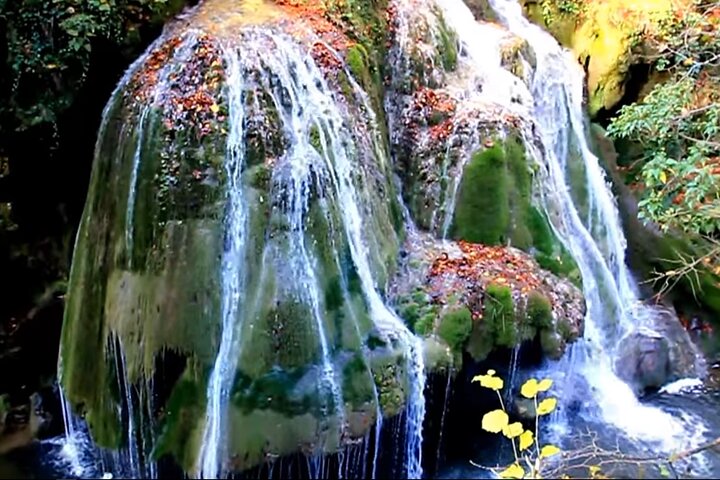
- Exclusive private car service including Tourism or Minibus for personal use.
- All entrance and photo fees covered in the itinerary.
- Dedicated English speaking guide/driver with proper licensing throughout the tour.
- Free Wi-Fi in a comfortable car for connectivity on the go.
-
Guide’s accommodations, meals, and entrance fees handled.
-…
- Exclusive private car service including Tourism or Minibus for personal use.
- All entrance and photo fees covered in the itinerary.
- Dedicated English speaking guide/driver with proper licensing throughout the tour.
- Free Wi-Fi in a comfortable car for connectivity on the go.
- Guide’s accommodations, meals, and entrance fees handled.
- Comprehensive car-related expenses such as gasoline, parking, and tolls included.
- Flexible itinerary with the option to modify daily plans after tour commencement.
- Accommodation, meals and beverages (we can recommend)
- Entrance fees as per the itinerary
- Accommodation, meals and beverages (we can recommend)
- Entrance fees as per the itinerary
Embark on an unforgettable 9-day journey through Romania, where a variety of intense sensory encounters await you. From ancient sites to a touch of the wild, featuring dense woods, brightly-hued wildflowers, and refreshing mountain air (depending on the season), culminating in contemporary displays. And, of course, a sprinkling of traditional seasonings…
Embark on an unforgettable 9-day journey through Romania, where a variety of intense sensory encounters await you. From ancient sites to a touch of the wild, featuring dense woods, brightly-hued wildflowers, and refreshing mountain air (depending on the season), culminating in contemporary displays. And, of course, a sprinkling of traditional seasonings in the delicious cuisine we’ll sample in every medieval town we explore. The ultimate method to comprehend Romania and its people - a private 9-day tour of Romania with a local guide :) We invite you to join us!
For a full refund, cancel at least 24 hours before the scheduled departure time.
For a full refund, cancel at least 24 hours before the scheduled departure time.




